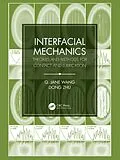Understanding the characteristics of material contact and lubrication at tribological interfaces is of great importance to engineering researchers and machine designers. Traditionally, contact and lubrication are separately studied due to technical difficulties, although they often coexist in reality and they are actually on the same physical ground. Fast research advancements in recent years have enabled the development and application of unified models and numerical approaches to simulate contact and lubrication, merging their studies into the domain of Interfacial Mechanics.
This book provides updated information based on recent research progresses in related areas, which includes new concepts, theories, methods, and results for contact and lubrication problems involving elastic or inelastic materials, homogeneous or inhomogeneous contacting bodies, using stochastic or deterministic models for dealing with rough surfaces. It also contains unified models and numerical methods for mixed lubrication studies, analyses of interfacial frictional and thermal behaviors, as well as theories for studying the effects of multiple fields on interfacial characteristics. The book intends to reflect the recent trends of research by focusing on numerical simulation and problem solving techniques for practical interfaces of engineered surfaces and materials.
This book is written primarily for graduate and senior undergraduate students, engineers, and researchers in the fields of tribology, lubrication, surface engineering, materials science and engineering, and mechanical engineering.
Autorentext
Q. Jane Wang received her Ph. D. in mechanical engineering from Northwestern University, IL, USA, in 1993. She taught for five years at Florida International University, Miami, FL, USA, and is now a Professor in the Mechanical Engineering Department at Northwestern University, USA. She was elected Fellow of the American Society of Mechanical Engineers (ASME) in 2009 and Society of Tribologists and Lubrication Engineers (STLE) in 2007. Her research interests are mainly in the areas of contact and interfacial mechanics and tribology of advanced materials and novel lubricants.
Dong Zhu received his Ph. D. in mechanical engineering from Tsinghua University of China in April of 1984. He started to work at the Center for Engineering Tribology, Northwestern University, USA, as a Research Fellow in January of 1986. He joined the Technical Center of Aluminum Company of America in the beginning of 1991 then Eaton Innovation Center in 1994, doing tribology and surface engineering related research and product development. After his retirement from Eaton, he was appointed to a Professor position at Sichuan University of China and Adjunct Professor at Tsinghua University. He is now an Adjunct Professor at Harbin Engineering University. He was elected Fellow of the American Society of Mechanical Engineers (ASME) in 2007 and Society of Tribologists and Lubrication Engineers (STLE) in 2006. His research interests mainly include elastohydrodynamic lubrication (EHL), mixed lubrication, surface engineering and tribological testing.
Inhalt
Chapter 1 Introduction
- 1.1. Significance of the Topics
- 1.2. Tribological Interface Systems
- Interface Systems Defined Based on Geometry
- Interface Systems Defined Based on Relative Motion
- Interface Systems Defined Based on Lubricating Media
- Interface Systems Defined Based on Lubrication Status
- 1.3. Brief Historic Review
- 1.3.1. Empirical Knowledge Accumulated in Early Years
- 1.3.2. Pioneering Studies
- 1.3.3. Establishment of Contact Mechanics and Lubrication Theory
- 1.3.4. Rapid Development Assisted by Digital Computers
- 1.3.5. Recent Advancements
- 1.3.6. Conclusion Remarks
- 1.4. Interfacial Mechanics
- 1.5. Coverage of This Book
- Mechanical Properties of Typical Solid Materials
- Topographic Properties of Engineering Surfaces
- Engineering Surfaces
- Surface Characterization by Statistic Parameters
- Surface Characterization by Direct Digitization
- Rough Surfaces Generated by Computer
- Lubricant Properties
- Viscosity
- Effect of Temperature on Viscosity
- Effect of Pressure on Viscosity
- Density
- Non-Newtonian Behaviors
- Additives in Lubricants
- 3.1. Introduction
- 3.2. Basic Half-Space Elasticity Theories
- 3.3. Line Contact Hertzian Theory
- 3.3.1. Basic Model
- 3.3.2. Contact Pressure and Surface Deformation
- 3.3.3. Subsurface Stresses
- 3.4. Point Contact Hertzian Theory
- 3.4.1. Basic Model
- 3.4.2. Contact Pressure and Surface Deformation
- 3.4.3. Subsurface Stresses
- Contact Strength Analysis Based on the Subsurface Stress Field
- Theories for Yield Criteria
Chapter 2 Properties of Engineering Materials and Surfaces
Chapter 3 Fundamentals of Contact Mechanics
3.2.1. Potential Equations
3.2.2. Displacements Due to Normal Loading
3.2.3. Displacements Due to Tangential Traction
3.2.4. General Equations for Surface Displacements
3.2.5. Subsurface Stresses
3.5.2. Subsurface Stress Field and Yield Pressure in Line Contacts
3.5.3. Subsurface Stress Field and Yield Pressure in Circular Contacts
3.5.4. Subsurface Stress Field in Elliptical Contacts
3.5.5. Effect of Friction on the Subsurface Stresses
3.5.6. Contact Yield Initiation in a Case Hardened Solid
3.5.6.1. Basic Model
3.5.6.2. Solution for Circular Contacts
3.5.6.3. Solution for Line Contacts
3.5.6.4. General Expressions
3.6. Selected Basic Solutions
3.6.1. Displacements Due to Concentrated Forces
3.6.2. Surface Displacements Induced by Uniform Pressure
3.6.2.1. 2D Plane Strain Problems
3.6.2.2. 3D Half-Space Problems
3.6.3. Indentation by a Rigid Punch
3.6.4. Frictionless Indentation by a Blunt Wedge or Cone
3.6.5. A Sinusoidal Wavy Surface in Contact with a Flat
3.6.5.1. 2D Wavy Surface
3.6.5.2. 3D Wavy Surface
3.7. Contact with Rough Surfaces
3.7.1. A Stochastic Model for Rough Surface Contacts
3.7.2. Empirical Formulae Based on Numerical Solutions for Rough Surface Contacts
3.7.2.1. Empirical Formulae by Lee and Ren (1996)
3.7.2.2. Empirical Formulae by Chen et al. (2007)
3.8. Contact of Multilayer Materials
3.8.1. Problem Description
3.8.2. Fourier Transforms of the Governing and Boundary/Interfacial Equations
3.8.3. Structures of B and AC Matrices
3.8.3.1. B Matrix and B Matrix Equation
3.8.3.2. AC Matrix and AC Matrix Equation
3.8.4. Solutions of Matrix Equations
3.8.5. Typical Sample Cases
3.8.6. Solution for Problems with a Single Layer Coating
3.8.7. Extended Hertzian Theories
3.9. Closure
Chapter 4 Numerical Methods for S…
